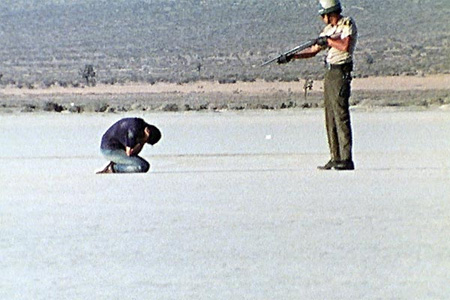How to pick a sequence from a film as determinedly divisive as this one? Start at the end. For the last sequence of Peter Watkins’ 1971 documentary-style fiction, a government-run “punishment program” recapitulates themes running all along the course of this grueling 88-minute work. Simply put, the government will utilize every force at its disposal to brutally crush dissent, and that includes torture and wholesale slaughter.
Shot rather quickly and simply for a mere $91,000 after a large-scale project about the U.S. Civil War fell through, Punishment Park, like most Watkins works (on display in Norway right now), features a non-professional cast and an overall approach to filmmaking that’s polar opposite to the Hollywood status quo. The setting is a rocky desert area set aside for the trial and punishment of dissidents in accordance with the “Internal Security Act of 1950, 64 Stat. 993,” also known as the “Subversive Activities Control Act” or the “McCarran Act,” called not only for the governmental register of members of the U.S. Communist Party, but also an “Emergency Detention statute,” giving the President the authority to “apprehend and detain each person as to whom there is a reasonable ground to believe will engage in, or probably will conspire with others to engage in, acts of espionage or sabotage in times of war or internal security emergency.”
Whatever that is.
In 1971 the so-called “Non-Detention Act” was passed to repeal specifically Title II, the “Emergency Detention Act,” stating, “No citizen shall be imprisoned or otherwise detained by the United States except pursuant to an Act of Congress.” But as we have seen in the wake of the attack of the World Trade Center in 2001, the government has contrived all manner of ways to keep that portion of the act alive, especially as regards to “rendition” of suspects for “enhanced interrogation” in foreign countries as well as the continued maintenance of the Guantanamo Bay prison in Cuba (the closure of which was President Barack Obama’s most singular campaign promise).
Simply put, the government will utilize every force at its disposal to brutally crush dissent, and that includes torture and wholesale slaughter.
But that’s a contemporary matter. Punishment Park was made at the height of the Vietnam War and in the immediate wake of the Kent State massacre, where National Guard troops gunned down four unarmed students during an anti-war protest. Would McCarran Act style detention be next? If so, the film seems to say, this might be what it would be like. Watkins shows a group of young people, black and white, brought before a government created “Tribunal” and told, over the vigorous objections of their lawyer, that they face lengthy incarceration or can choose to spend four days in “Punishment Park.” There they will be tasked to run across 52 miles of rocky terrain without food or water in the hopes of reaching an American Flag that has been posted as the end point of their ordeal. As is quickly made clear, chances of reaching this goal are slim as the army is set to send troops to hunt down the prisoners a short interval after the start of their trek. And even though a European film crew is on hand to document the occasion, the military has no compunction about abusing not just the prisoners but even these camera-equipped witnesses.
Though the action proceeds in a generally linear way Watkins frequently cuts back to its start, and the confrontation of the prisoners with the court, clearly evoking the Chicago 8 trial as one black prisoner makes his feelings plain and is tied up and muzzled by the officers precisely as Black Panther Bobby Seale was at that memorable trial, called to punish leaders of the anti-war protests at the 1968 Chicago Democratic National Convention. The police who mercilessly beat protesters were of course not charged at all.
In the last sequence of Punishment Park a turn of events that could only happen in a Peter Watkins film, thanks to his insistence of improvising with non-professionals, memorably unfolds. While the script indicated that “law enforcement officers” were supposed to shoot two of the five surviving prisoners and capture the remaining three, an actor playing an officer, having been struck by a rock thrown by one of the prisoners—beyond frustration at being prevented from reaching their flag-post goal—dropped to his knees and fired a round at the rock-thrower. This spontaneous act caused Watkins to call out, “Oh God! Oh Christ! Cut! Cut! Cut the Camera!’ fearing that an actual attack had taken place. It hadn’t, but this “gaffe” gives the film the climactic moment it needs.
Punishment Park is not an easy film to watch and almost impossible to “like,” but in an era when government-run assassination programs are transformed into the sentimental teenage fantasies of The Hunger Games, the power and above all purity of Watkins vision rises above it all as never before.
Make no mistake—the “Park” is still up and running.




